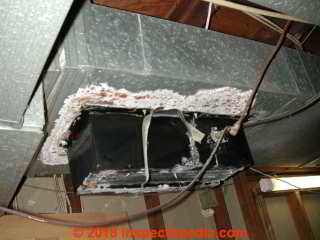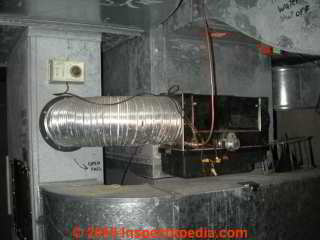 Central Humidifiers in Buildings
Central Humidifiers in Buildings
Using a home humidifier on a furnace air handler
- POST a QUESTION or COMMENT about the proper indoor humidity level & how to get there - dehumidifiers & moisture source control
Central humidifiers.
Central humidifier installation, use, cleaning, connections, & building codes. Should a central humidifier be used at all on a heating system? Where would a central humidifier best be located?
How is water supply conducted to a humidifier? Should you pipe hot water to the central humidifier system? Central humidifier cleaning, maintenance, & health effects or risks.
InspectAPedia tolerates no conflicts of interest. We have no relationship with advertisers, products, or services discussed at this website.
- Daniel Friedman, Publisher/Editor/Author - See WHO ARE WE?
Using a Central Humidifier Attached to a Heating Furnace
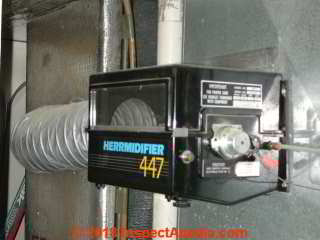 Question: how to connect hot water to a central humidifier
Question: how to connect hot water to a central humidifier
2018/01/11 Eric said:
I've added a humidifier to my furnace and would like to use hot water (recommended by manufacturer) from my hot water heater to supply water to the humidifier.
[Click to enlarge any image]
Can I screw a T-Valve into my water shutoff valve, add a new shutoff on the other end of the T-Valve, and use this to supply my humidifier without violating codes?
Correction: I meant to ask if I can screw a T-Valve onto my water heater drain valve on the bottom, not onto the water shutoff valve.
This question and answer were posted originally
Reply: OPINION: this connection is not-recommended
Eric,
I do not think a T-valve would be the proper application for providing hot water to your system humidifier.
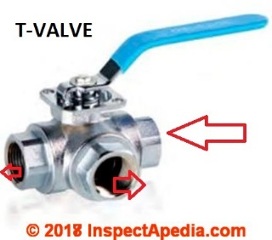 Typical T-valves such as the Mondeo T-valve I illustrate here, are ball-valves used to divert flow from a primary input source to one of two different destinations.
Typical T-valves such as the Mondeo T-valve I illustrate here, are ball-valves used to divert flow from a primary input source to one of two different destinations.
The ball of the T-valve is drilled straight through and then an intersecting drill opening is made at a 90 degree angle to the first passage.
Ball valves are intended to be used in the fully-open or fully closed position, though some suppliers describe using a T-valve to permit sending output to two destinations simultaneously - you'd see reduced flow rate to both of them compared with a straight ball valve or an L-valve.
More about T-valves and L-valves is at PLUMBING CONTROLS & VALVES
Also there could be a risk of pressure-loss and backflow of unsanitary water from the humidifier to the building water heater or plumbing system (though double check valves could mitigate that risk).
The simplest installation uses a saddle valve that punctures a hot water line (or in my OPINION better, a cold water line) and uses a small diameter flexible copper tube to conduct water to the humidifier. However many plumbing codes no longer permit these valves.
Instead, in my OPINON, it would make more sense to simply install a tee in the hot water supply piping (or in my OPINION better to cold water piping) and then connect a simple ball-valve or gate valve (to permit flow adjustment) in line with the outlet of the tee that will feed the humidifier.
Unless you are going to keep filling your humidifier manually, and unless your humidifier includes a water feed control in its design, you'd want a sanitary float control valve to admit water into the humidifier.
BOTTOM LINE: drop the whole idea of connecting hot water to the humidifier and I would reconsider using a central humidifier at all
 Why do we express this opinion?
Why do we express this opinion?
There might be a small improvement in the production of moisture being sent into your furnace supply plenum or supply air duct by using hot water, but that benefit is likely to be offset by the formation of mineral scale and crud that HVAC technicians find troublesome as scale fouls controls and moving parts and increases service cost.
OPINION: frankly I am not a fan of central humidifiers that feed water into a supply plenum over a furnace heat exchanger.
In over 40 years of building inspections I have seen that most of the central humidifiers I've seen installed were not maintained, were not working, and many of them had leaked into and caused costly, even dangerous damage to the furnace heat exchanger.
Central humidifiers also can serve as mold amplifiers and mold distributors in buildings. (Solomon 1976).
For those reasons I prefer point-of-use portable humidifiers such as in sleeping areas.
See also CENTRAL HUMIDIFIER LEAKS into DUCTWORK
Watch out: do not try feeding hot water from your water heater's drain valve. You will have chosen the worst place to feed hot water into a humidifier as you'll be draining sludge and scale from the bottom of the water heater.
Research on Using a Central Humidifier in Homes
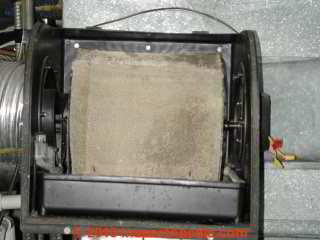 Photo: a central humidifier attached to the supply air plenum of a home heating furnace, showing a rotating drum that is encrusted with scale and debris. It is common to find that homeowners do not clean nor maintain the central humidifier. [Click to enlarge any image]
Photo: a central humidifier attached to the supply air plenum of a home heating furnace, showing a rotating drum that is encrusted with scale and debris. It is common to find that homeowners do not clean nor maintain the central humidifier. [Click to enlarge any image]
- Mohan, Aparna K., Charles E. Feigley, and Caroline A. Macera. "Humidifier use in the home environment and its effects on respiratory health." Applied occupational and environmental hygiene 13, no. 11 (1998): 782-787.
Abstract:
This study sought to examine the association between household humidifier use and subsequent experiencing of adverse health symptoms.
The analyses were based on a cross-sectional survey of 101 people residing in Chester County, South Carolina. Evaluation of the effect of exposure to different humidifier factors on the respiratory and general health of residents using humidifiers was achieved by univariate and multiple logistic regression analysis.
People who cleaned their humidifiers less frequently were more likely to report untoward health symptoms than people who cleaned their humidifiers frequently.
This relationship persisted even after controlling for the effects of potential confounding factors: age, gender, race, smoking, and educational status.
Infrequent humidifier cleaners had significantly higher odds of reporting adverse health symptoms like headache (adjusted odds ratio = 17.1), eye irritation (adjusted odds ratio = 9.9), sore throat (adjusted odds ratio = 11.1), nose irritation (adjusted odds ratio = 10.9), and cough (adjusted odds ratio = 14.3) than frequent cleaners.
Currently physicians and researchers have divided opinions about the benefits of humidifiers and vaporizers.
While increased humidity during winter months may reduce the number of respiratory infections and problems an individual experiences, results of this study indicate that proper maintenance of the equipment is equally important for preventing health problems. - Patterson, Roy, Jordan N. Fink, Wayne B. Miles, John E. Basich, Donald B. Schleuter, David G. Tinkelman, and Mary Roberts. "Hypersensitivity lung disease presumptively due to Cephalosporium in homes contaminated by sewage flooding or by himidifier water." Journal of Allergy and Clinical Immunology 68, no. 2 (1981): 128-132.
- Solomon, William R. "A volumetric study of winter fungus prevalence in the air of midwestern homes." Journal of Allergy and Clinical Immunology 57, no. 1 (1976): 46-55.
Abstract:
Volumetric recoveries of airborne, mesophilic microfungi were made during winter months at three specific points in 150 single-family dwellings in southeastern Michigan. Mean levels of total isolates/m3 comprised a range of from less than 10 to over 20,000, although concurrent outdoor levels never exceeded 230/m3.
Form species of Penicillium, Aspergillus, Cladosporium, and Rhodotorula as well as non-pigmented yeasts were the types encountered most widely indoors.
Certain homes showed high recoveries of other types, including Cephalosporium, Sporobolomyces, Verticillium, and Sporothrix form species.
A positive association between indoor fungus prevalence and bedroom relative humidity was strongly suggested, and high levels were observed in well-humidified homes despite the presence of electrostatic air cleaners.
The data indicate characteristic patterns of (winter) air spora in specific homes and suggest that humidifying devices may serve as dispersion sources in addition to their permissive role in facilitating fungus growth.
...
Continue reading at HUMIDITY CONTROL & TARGETS INDOORS or select a topic from the closely-related articles below, or see the complete ARTICLE INDEX.
Or see these
Recommended Articles
- HUMIDITY CONTROL & TARGETS INDOORS
- CENTRAL HUMIDIFIERS in BUILDINGS - add needed moisture to building air
- DEHUMIDIFICATION BASICS - remove un-wanted moisture indoors
- DEHUMIDIFICATION PROBLEMS
- DEW POINT CALCULATION for WALLS
- HUMIDITY MEASUREMENT INSTRUMENTS
- HUMIDITY RESPONSE, NEST THERMOSTATS
- MOISTURE CONTROL in BUILDINGS - home
- INDOOR AIR QUALITY & HOUSE TIGHTNESS
- HUMIDITY CONTROL with SUPPLY-ONLY or PIV VENTILATION SYSTEMS
- HUMIDITY LEVEL TARGET
- HUMIDITY MEASUREMENT INSTRUMENTS
- INDOOR AIR QUALITY & HOUSE TIGHTNESS
- Legionella BACTERIA & HVAC EQUIPMENT
- MOISTURE in BUILDING WALLS, EFFECTS
- MOLD: A COMPLETE GUIDE TO MOLD
- VENTILATION in BUILDINGS - home
- WET CORRODED DUCT WORK - dangers of using a central humidifier?
Suggested citation for this web page
CENTRAL HUMIDIFIERS in BUILDINGS at InspectApedia.com - online encyclopedia of building & environmental inspection, testing, diagnosis, repair, & problem prevention advice.
Or see this
INDEX to RELATED ARTICLES: ARTICLE INDEX to BUILDING LEAKS & WATER ENTRY
Or use the SEARCH BOX found below to Ask a Question or Search InspectApedia
Or see
INDEX to RELATED ARTICLES: ARTICLE INDEX to BUILDING VENTILATION
Or use the SEARCH BOX found below to Ask a Question or Search InspectApedia
Or see
INDEX to RELATED ARTICLES: ARTICLE INDEX to BUILDING INDOOR AIR QUALITY IAQ
Or use the SEARCH BOX found below to Ask a Question or Search InspectApedia
Ask a Question or Search InspectApedia
Try the search box just below, or if you prefer, post a question or comment in the Comments box below and we will respond promptly.
Search the InspectApedia website
Note: appearance of your Comment below may be delayed: if your comment contains an image, photograph, web link, or text that looks to the software as if it might be a web link, your posting will appear after it has been approved by a moderator. Apologies for the delay.
Only one image can be added per comment but you can post as many comments, and therefore images, as you like.
You will not receive a notification when a response to your question has been posted.
Please bookmark this page to make it easy for you to check back for our response.
IF above you see "Comment Form is loading comments..." then COMMENT BOX - countable.ca / bawkbox.com IS NOT WORKING.
In any case you are welcome to send an email directly to us at InspectApedia.com at editor@inspectApedia.com
We'll reply to you directly. Please help us help you by noting, in your email, the URL of the InspectApedia page where you wanted to comment.
Citations & References
In addition to any citations in the article above, a full list is available on request.
- Nuiaire Best Practicve Installation Guide [for] Mechanical Heat Recovery Ventilation (MVHR), Nuaire Group Western Industrial Estate Caerphilly CF83 1NA, U.K., Tel: 029-2088-5911 in the U.K., email: info@nuaire.co.uk, International Tel: +44 29 2085 8497, International Email: international@nuaire.co.uk retrieved 1/1/2015, original source: http://www.nuaire.info/bpguides/BestPracticeInstallationGuide-MVHR.pdf
- WHO Guidelines for Indoor Air Quality: Dampness and Mould (World Health Organization Europe), WHO Regional Office for Europe, ISBN-10: 9289041684, ISBN-13: 978-9289041683
When sufficient moisture is available, hundreds of species of bacteria and fungi -- particularly mold -- pollute indoor air. The most important effects of exposure to these pollutants are the increased prevalence of respiratory symptoms, allergies and asthma as well as disturbance of the immune system. Preventing (or minimizing) persistent dampness and microbial growth on interior surfaces and building structures is the most important means of avoiding harmful effects on health.
This book provides a comprehensive overview of the scientific evidence on the health problems associated with this ubiquitous pollution and provides WHO guidelines to protect public health. It also describes the conditions that determine the presence of mould and provides measures to control its growth indoors. - Olalekan F. Osanyintola, Carey J. Simonson, Moisture buffering capacity of hygroscopic building materials: Experimental facilities and energy impact, article within Energy and Buildings,
Abstract Research into dynamic moisture storage in hygroscopic building materials has renewed interest in the moisture buffering capacity of building materials and shown the potential for these materials to improve indoor humidity, thermal comfort and indoor air quality in buildings. This paper complements previous research by estimating the effect of hygroscopic materials on energy consumptions in buildings. The results show that it may be possible to reduce heating and cooling energy consumption by up to 5% and 30%, respectively, when applying hygroscopic materials with well-controlled HVAC systems. The paper also describes two different experimental facilities that can be used to measure accurately the moisture buffering capacity of hygroscopic building materials. These facilities provide different convective transfer coefficients between the hygroscopic material and ambient air, ranging from natural convection in small, sealed jars to fully developed laminar and turbulent forced convection. The paper presents a numerical model and property data for spruce plywood which will be used in a companion paper [O.F. Osanyintola, P. Talukdar, C.J. Simonson, Effect of initial conditions, boundary conditions and thickness on the moisture buffering capacity of spruce plywood, Energy and Buildings (2006), doi:10.1016/j.enbuild.2006.03.024.] to provide additional insight into the design of an experiment to measure the moisture buffering capacity of hygroscopic materials. Keywords Moisture buffering capacity; Energy savings; Experimental facility; Uncertainty; Indoor air quality; Convective transfer coefficients; Spruce plywood - Olalekan F. Osanyintola, Prabal Talukdar, Carey J. Simonson Effect of initial conditions, boundary conditions and thickness on the moisture buffering capacity of spruce plywood Energy and Buildings, Volume 38, Issue 10, October 2006, Pages 1283-1292
- Our recommended books about building & mechanical systems design, inspection, problem diagnosis, and repair, and about indoor environment and IAQ testing, diagnosis, and cleanup are at the InspectAPedia Bookstore. Also see our Book Reviews - InspectAPedia.
- In addition to citations & references found in this article, see the research citations given at the end of the related articles found at our suggested
CONTINUE READING or RECOMMENDED ARTICLES.
- Carson, Dunlop & Associates Ltd., 120 Carlton Street Suite 407, Toronto ON M5A 4K2. Tel: (416) 964-9415 1-800-268-7070 Email: info@carsondunlop.com. Alan Carson is a past president of ASHI, the American Society of Home Inspectors.
Thanks to Alan Carson and Bob Dunlop, for permission for InspectAPedia to use text excerpts from The HOME REFERENCE BOOK - the Encyclopedia of Homes and to use illustrations from The ILLUSTRATED HOME .
Carson Dunlop Associates provides extensive home inspection education and report writing material. In gratitude we provide links to tsome Carson Dunlop Associates products and services.


